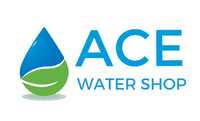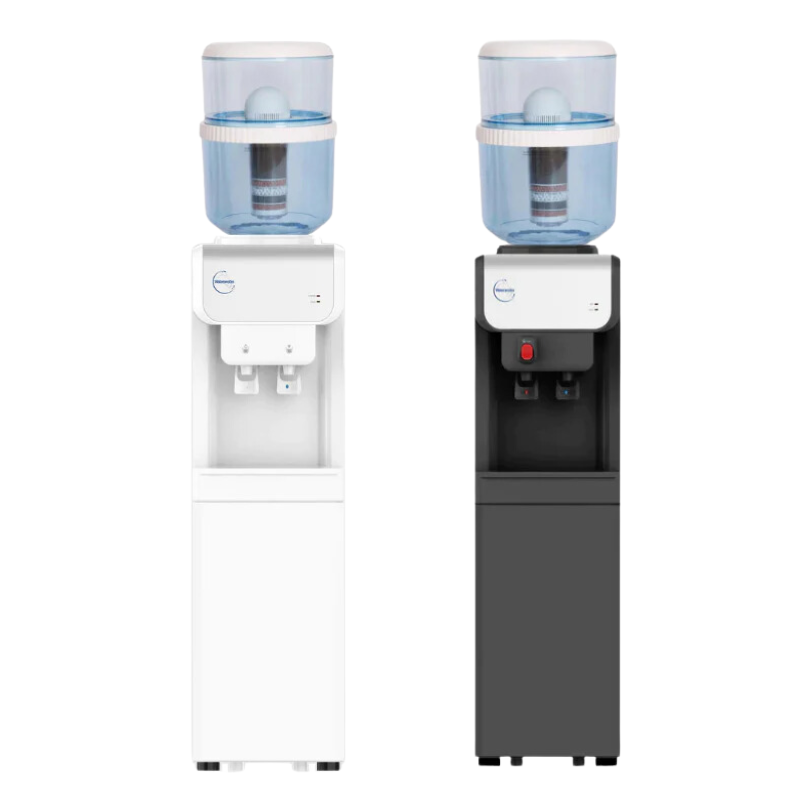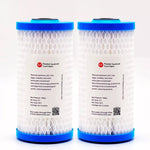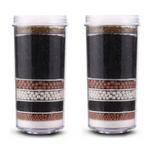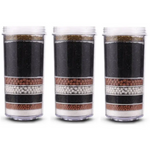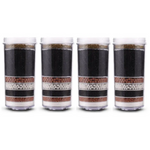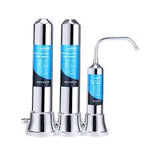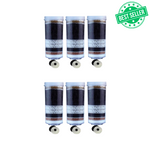You have no items in your shopping cart.
It's no wonder that many individuals are shifting to using a water dispenser instead of tap water. It's because lead, copper, nitrates, germs, fertilisers, and pesticides can all be found. Water dispensers deliver cool, fresh water anytime you require it. Although they're all convenient, cost-effective, and convenient to use, not every water dispenser is created equal.
Top loading, bottom loading, and point of use water dispensers all directly connect to your water system and never need to be replenished. Each has its own set of benefits and drawbacks, but which one would work just fine in your home or office?
TYPES OF WATER DISPENSERS AND BENEFITS
Bottom Loading Water Dispensers
To make loading easier, bottom-loading water dispensers have the container located at the bottom of the unit. The device comes with a cap and hose that fits over the top of the bottle and extends down to the bottom, connecting to the bottled water jug and pumping up the water needed to fill the tanks once the tap is turned on.
Put the bottle into the bottom of the water cooler to complete the installation. It has a shorter design to accommodate the water bottle at the bottom. It makes it a smart choice for individuals with limited space.
The majority of bottom-loading water dispensers are identical to top-loading water dispensers in terms of size. The most noticeable distinction is that because the water jug is housed within the bottom half of the dispenser, bottom-loading water dispensers aren't as tall when the water jug is set up. As a result, they're great for small places.
It's simple to refill a bottom-loading water dispenser. All you have to do now is slide the water jug into the water dispenser's space. After that, you may set up the pump and pipe, which will allow you to get water from the water jug.
A bottom-loading water dispenser has a higher price tag than a top-loading water dispenser. It's owing to the bottom-loading water dispenser's distinctive shape and the fact that they are slightly more convenient.
Benefits of Using a Bottom Loading Water Dispenser
- This type of dispenser is a straightforward and efficient water cooler that's simple to set up and maintain.
- They eliminate the risk of spills that can occur when refilling the water bottle.
- Lifting the large jugs is made easier with the bottom loading design, which prevents back pain.
- It has a sleek, modern style that gives it a crisp, cleaner appearance and allows it to integrate more readily with your kitchen's decor.
Top Loading Water Dispensers
These dispensers use water bottle containers that are placed on top of the cooler and automatically feed the water tank below, as the name implies. Top-loading dispensers employ an air pipe to pump water down, providing chilled and hot water quickly.
In top loading water dispensers, water jugs are placed on top of the cooler and flow directly into the water reservoir below. These jugs are provided by companies that undergo extensive cleansing before arriving at your home. Although not all organisations purify their water similarly, some of the usual treatments include carbon filters to filter pesticides and heavy metals. Some also use UV radiation to deconstruct and eliminate germs, and ozone to kill any pathogens. The firm also removes any remaining chlorine, resulting in water that tastes cleaner than tap water.
Top-loading water dispensers are tall because they rely on a huge plastic jug that must be linked to the top. They're so tall that some places can't accommodate them. As a result, think about where a top-loading water dispenser would go and whether it would be appropriate for your space.
Because most water jugs are hefty, refilling a top-loading water cooler can be a little difficult. Picking them up, turning them upside down, and putting them on the water dispenser can be a pain due to their weight.
Benefits of Using a Top Loading Water Dispenser
- The majority of top-loading dispensers are compact. It makes them easy to transport and use.
- The body is constructed of high-strength plastic that is easy to maintain.
- It makes it easier to get water and makes drinking water more convenient.
- It provides a continuous flow of both cold and hot water.
Point of Use Water Dispensers
Bottomless water dispensers, also known as point-of-use water dispensers, are connected directly to the plumbing in your home or office. They use the same water that comes out of your sink and shower faucets. To provide the same level of water quality, point-of-use water coolers require several water filters to remove chlorine, metals, germs, and other pollutants. These filtration systems could be complicated.
Benefits of Point of Use Water Dispensers
If you've been thinking about getting a bottleless water dispenser for your office, these upgraded options can offer some benefits over standard bottled water options that are worth investigating.
- Better than traditional water dispensers.
- Healthier water
- Cost-effective
- Convenient and hassle-free
- No more bottles
INSTALLATION
Top Loading
It's easy to set up a top-loading water dispenser. It's made of lightweight, high-strength plastic that's simple to transport. Most are under forty pounds and can be moved by one or two individuals. They plug into normal electrical outlets, so finding a space for them is simple. Just make sure there's enough room above it for your water bottle. They can raise the height of the dispensers by 1-2 feet.
Bottom Loading
Water dispensers with a bottom loading spout are composed of the same elements as those with a top loading spout. The only significant variation is the water pump used to draw water into the water reservoir. However, it has only a minor impact on the weight. They may be moved and maneuvered with similar simplicity as top-loading water dispensers. Their main advantage is their small size. They're substantially shorter than top-loading dispensers and may fit into more areas because the bottle is kept in the base.
Point of Use
Point of use water dispensers seems to be the only water dispensers that require a professional plumber to install since their water is routed directly from your house or office's plumbing system. You will need one to inspect your piping and connect your water dispenser to the nearest cold-water line. The good news is that this procedure takes far less time than it appears. You can put up most point-of-use water dispensers in under an hour. But once they're in place, you can't move them without sending in another professional to disconnect and re-seal the pipes.
REFILLING

Top Loading
Refilling top-loading water dispensers is tough since it requires lifting the bottle and placing it on top of the machine, which is more difficult than it appears. A five-gallon jug of water weights more than 40 pounds, and lifting one wrong can result in back pain. When taking it up, never lean over at the waist. Instead, squat and raise your knees. It will prevent you from putting undue strain on your back.
Before lifting the bottle, hold the neck and lean it gently to acquire a strong grasp on the base. Splashing is a problem, so after it's up, tip the bottle's mouth down into the top of the water dispenser and elevate the bottom. It won't only reduce splashing, but it will also reduce strain. A bottle spike is included in the baffle of some top-loading water dispensers. The tip pokes a hole in the cap as you drop it into the dispenser, rather than ripping off the top and pouring the water in. The water drains into the reservoir without ever coming into contact with you. It's practical and cuts down on time spent fiddling with the bottle.
Bottom Loading
It's simple to refill a bottom-loading water dispenser. A cap and hose go over the top of the bottle. Then, it reaches down to the bottom, included with the dispenser. All you have to do now is peel the top of the bottle's seal and replace it with the cap. After that, slip the container into the water cooler's base, and you're done. As normal, turn on the water taps, and the pump will gobble up as much water as is needed to fill the tanks. It's far easier than lifting a 5-gallon water jug, and there's no danger of leaking water on yourself or the carpet.
Point of Use
The real benefit of a point-of-use water cooler is that it does not require refilling. The water flow is constant after the device is set up. The filters are the only thing that needs replacement, and they usually last 6-12 months. It would help if you manually changed some filters. Others require a corporate representative to go out and assist, but these visits are frequently free of charge.
WATER COOLER DISPENSER FOR SALE COSTS

Top Loading
The cheapest water dispensers on sale are top loading water dispensers. Depending on the sort of dispenser you select, prices can range from $110 to $200. The majority of top-loading dispensers are inexpensive. Some will set you back $250 or $300, but these are the exceptions.
Water jugs, which are used in top-loading water dispensers, can have a large long-term expense. Each month, a family of two to five people will likely consume three to four five-gallon jugs of water. Delivery costs $7-$8 per jug. Thus monthly prices are typical $21-$32. If you work in a 10-person office, you'll typically drink 6-8 jugs of water each month ($42-$64), and offices with 25 employees will consume 17-20 jugs per month ($119- $160). Water expenses may be very high for large enterprises, and prices continue to climb as more people are added.
So instead of paying you per bottle, other delivery firms charge a flat cost, and their prices are typically lower. Some companies charge as low as $10 per month, although if you work for a large firm and need more delivery, you may be charged more. You can manually refill water bottles at refill stations in your local grocery or convenience store. However, this is usually only an alternative for small families or very small enterprises due to the effort necessary to carry a full, 5-gallon water jug.
Bottom Loading
Bottom-loading water dispensers are more expensive than top-loading water dispensers, yet they function at the same cost. The cost of the purchase ranges from $170 to $245. Add the price of the bottled water.
Point of Use
Water dispensers with a point of use have the highest initial expenses but the cheapest operational expenses of any water dispenser. They range from $300 to $400, but they only cost pennies to run—nothing more than the cost of turning on the tap. Because most local tap water charges a penny for four gallons, 100 gallons (20 5-gallon water bottles) costs only $0.25.
HOW TO CHOOSE THE BEST WATER COOLER DISPENSER FOR YOU
A water dispenser is an ideal way to improve your drinking water strategy by providing easy access to clean, safe water. You can select a variety of styles and models to help you establish new water dispenser behaviors.
There are several dispensers, stainless steel ones, and a variety of other options that will blend in with your surroundings or add a touch of modern sophistication to your office. Different water dispensers are bottom-loading, top-loading, freestanding, and wall-mounted. Other solutions include dry storage chambers for cups and bottles that offer safety and limit cross-contamination without taking up too much room.
Your decision will be based on your necessities. Regardless of which sort of water dispenser you choose, the benefits are the same for all of them.
FACTORS TO CONSIDER IN BUYING A WATER DISPENSER
Where to Use It
You must evaluate all of the viewpoints that come with that specific zone, depending on where you intend to use it. If you use a water dispenser at home, get one that has a lock. You could require something easy to set up on your kitchen counter. If you're going to use it in a workplace for guests or employees, get a bigger one that can handle both hot and cold water. It will be simple to give both hot and cold beverages as a result of this.
Water Supply
When employing a water container for water supply or rapid line access, it's recommended to consider a direct line or refillable bottle dispenser. This dispenser can be used in your home and connected to your water pipes to channel fluids.
Portability
It is preferable to select a portable model because it will be less expensive and will not demand a lot of storage space. If you don't have anywhere to store it, you can attach it to the sink or leave it on the counter for use.
Water Source
It would be best if you considered the water supply that comes with your water dispenser. The one you choose will be determined by the type of water you're using. Make sure it comes with a tap or can be used with other water sources like a well or a stream. If you need a faucet for your water supply, look for one which comes with a hose or attach it to your sink with an external hose.
Cost
The cost of the water dispenser will be determined by a variety of criteria, including its size and intended audience. When choosing a water dispenser, you have a few options. The most common options are purchasing one from a local store, ordering one online, or seeking a free estimate for your water dispenser.
BUY A WATER COOLER AND DISPENSER FROM ACE WATER SHOP
Water dispensers exist in a variety of shapes, sizes, costs, and functions, and they all have advantages and disadvantages. Before making a decision, you should compare them against your requirements. Because some of these water coolers can be used for a variety of purposes, choose wisely.
Ace Water Shop offers different types of water cooler dispensers for your home and office in Australia. Contact us today so we can help you figure out the best kind of water dispenser for you.
